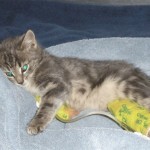 Anesthesia will be a necessity at some point in your pet’s life. With all types of anesthesia come certain risks. To make anesthesia less risky than driving your pet to our hospital, extra precautions need to be taken before, during, and after your pet’s anesthetic event. These extra precautions are necessary for your pet’s safety and to ensure a long, happy life with you.
Anesthesia will be a necessity at some point in your pet’s life. With all types of anesthesia come certain risks. To make anesthesia less risky than driving your pet to our hospital, extra precautions need to be taken before, during, and after your pet’s anesthetic event. These extra precautions are necessary for your pet’s safety and to ensure a long, happy life with you.
Only when the benefits of anesthesia outweigh the risks, will anesthesia be performed.
Before Anesthesia The following steps allow your veterinarian to design a personalized anesthetic plan for your pet and help avoid complications during anesthesia.
- A comprehensive physical exam is the first line of defense to detect any physical abnormalities. Your veterinari
 an will assess your pet’s physical appearance, palpate the internal organs and listen to the heart and lungs.
an will assess your pet’s physical appearance, palpate the internal organs and listen to the heart and lungs. - Blood testing, which typically includes a complete blood count and a chemistry profile, helps to identify hidden and potentially life threatening diseases not detectable on physical exam.
- Electrocardiogram (EKG/ECG) is used to detect any abnormal heartbeats or heart rhythms.
- Pre-operative pain management sets the stage to protect your pet against any anticipated pain. These medications also reduce the amount of anesthetic drugs your pet will receive during the procedure.
- An intravenous (I.V.) catheter is placed to deliver medications, to administer fluids during and sometimes after the procedure, and should the need arise, for immediate treatment of cardiovascular or respiratory distress.
- Pre-oxygenation. Your pet will breathe 100% oxygen, for about 5 minutes, before beginning general anesthesia to ensure the organs and tissues are working at full capacity.
During Anesthesia The same safety measures provided to you during anesthesia are provided here for your pet .
- Balanced anesthesia provides your pet with a combination of medications tailored to meet individual needs. Receiving a combination of medications allows your pet to require smaller doses of each medication, greatly reducing the chance of an adverse event.
- Surgery assistant is a veterinary nurse who is trained to perform anesthesia responsibilities. The nurse’s responsibilities include monitoring your pet throughout the procedure, adjusting medications based on your pet’s vital signs, and ensuring your pet remains safe and stable throughout the procedure.
- Monitoring equipment adds an additional layer of protection. Various equipment is used to monitor your pet’s blood pressure, heart rhythm, body temperature, oxygenation, breathing and heart rate.
- A warming unit, warm blankets and socks on the feet prevent your pet from getting cold during the proceedure.
- Intravenous (I.V.) fluids are delivered throughout the procedure to maintain blood pressure, support kidney function, and speed the recovery process.
- We prevent surgical pain through the use of local anesthesia before any incision is made or catheter is placed. For significantly painful procedures, additional strategies may be used, like epidurals and constant rate infusion (CRI) of potent pain relievers.
- An endotracheal tube is placed in the trachea (windpipe) to deliver oxygen and anesthetic gas, and to protect the lungs from aspiration of liquids
Recovery Appropriate post-operative care ensures a smooth recovery for your pet.
 Staying warm is very important while waking up from anesthesia. Each patient is wrapped in a warm blanket, which is changed often, to ensure each patient remains warm and cozy. Being warm helps metabolize anesthetic drugs faster. It is also more comfortable to wake up warm and not shivering.
Staying warm is very important while waking up from anesthesia. Each patient is wrapped in a warm blanket, which is changed often, to ensure each patient remains warm and cozy. Being warm helps metabolize anesthetic drugs faster. It is also more comfortable to wake up warm and not shivering.- A recovery nurse will awaken your pet from anesthesia. Being close to a person provides comfort to your pet while waking up in a strange place. It also adds an extra layer of monitoring, to ensure a smooth recovery.
- Post-operative pain medications are delivered as your pet recovers. Depending on the need, your pet may go home with additional pain medications.

